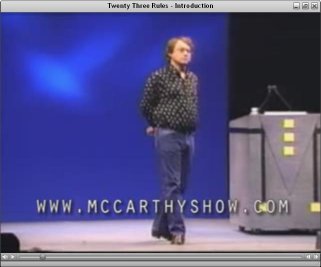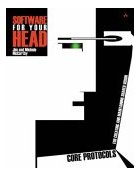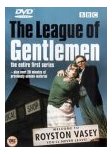|
|
 Jim McCarthy presenting at Microsoft Jim McCarthy presenting at Microsoft
If you haven’t seen it yet, go get the videos of Jim McCarthy’s talk at Microsoft from the podcast page of the McCarthy Show. While you’re at it, why haven’t you subscribed to the McCarthy Show, the show where Jim and Michelle McCarthy talk about “Software for your Head“?
Why should you see this presentation? It’s pre-“Presentation Zen“, pre-agile, yet you’ll find many things very familiar.
The talk is about the “23 Rules” of shipping software (back in the time when at least some people within Microsoft knew how to ship…). How many slides does Jim use? 23. Or 24, because there are really 23.5 rules.
Okay, the slides still contain bullets. I’m not too fond of the yellow and white letters on blue background, in the slides. The flow of the presentation is slowed down a bit by Jim going back to the computer to advance to the next slide. He could have used a remote or someone sitting behind the computer, to keep the flow.
But those are minor quibbles. Watch how Jim delivers the talk.
He starts the talk with “This reminds me of a story about Napoleon. Napoleon, incidentally, is a big idol of Bill’s. Big surprise!”. The story is about Napoleon having only one rule for management, a good introduction to the “23 rules” talk.
The delivery reminds me of a standup comedian’s act. See for example Rule #14 “Enrapture the customer”. He illustrates the fact that “most software sucks” with a a few self-deprecating jokes and an anecdote about a woman he met on a plane. Jim goes on a rant how bad Windows, Word and Excel are that this woman has to go to college for two years to learn how to use them. Finally, he gives an example from Visual C++ to illustrate how to listen to what a customer really wants. How to make the user go “Wow!”. Great advice, great passion, great delivery.
I’m quite sure that Visual C++ AppWizard was a “Wow!” feature for those people who didn’t really understand C++ or Windows programming (or even programming in general). I remember one ex-project manager of mine actually go “Wow!” when he ran his first AppWizard-generated “Windows app”. “Hey, this Windows programming thing is pretty simple!“, he said. Needless to say that our first Windows development project had a slightly “optimistic” schedule 🙂
There are other strong points in Jim’s delivery. Watch his timing: he knows when to leave a pause, let the audience laugh, think, catch their breath. Watch how he involves the (large) audience, how he asks them questions, especially “Does this problem sound familiar?”. Watch how he modulates the intensity of his talk, sometimes joking, then ranting, telling stories and anecdotes, giving advice…
 At the time this talk was given, the first edition of “Dynamics of Software Development” was probably out. I had read the book, but didn’t think that I could apply most of the advice contained in the book. At the time this talk was given, the first edition of “Dynamics of Software Development” was probably out. I had read the book, but didn’t think that I could apply most of the advice contained in the book.
Things only clicked when I read (AND understood, which took some time and re-reading) “Software For Your Head“. Jim alludes to what was to become the “Core protocols” a few times in the talk, for example when he mentions that his team is experimenting with ways to make the environment safe enough for people to express their best ideas.
The second edition of “Dynamics of Software Development” is out. Time to re-read the book and see all the things I missed first time. But first I have to read a few other books. That’s another story, for another day…
 Joseph Pelrine will be giving a SCRUM training course in Mechelen, Belgium on 4 and 5 October 2006. Joseph Pelrine will be giving a SCRUM training course in Mechelen, Belgium on 4 and 5 October 2006.
If you want to know what SCRUM and agile are, there are few people better placed to answer all your questions… or, more likely, to raise a lot more questions, knowing Joseph :-).
Joseph practiced agile before it was called agile, a.o. working with Kent Beck on Smalltalk projects. Joseph’s involvement in Smalltalk and agile is no coincidence. Smalltalk and the smalltalk projects Kent Beck did (including C3) were a major influence on XP. With all this experience, Joseph is a master story-teller. If you not only want to know what SCRUM is, but also the why, how and the history behind it all, come to this course!
Joseph was one of the speakers at XP Day Benelux in 2003. Will he make another appearance at XP Days Benelux in 2006? Watch this space if you want to know.
You can register for XP Day Benelux 2006 from today.
As you can see, the conference program isn’t filled in yet. The session organizers are still improving the session proposals until the end of the month. After that, the conference program committee will have the difficult task of choosing twenty-odd sessions from the 33 proposals.
If you’ve been to previous editions, you know what to expect. Based on the quality of the proposals, I think this year’s program will be even better than last year’s program. Whatever your role, intrests, background or knowledge about agile methods, you’ll find something interesting, something new, something you can use at work in this year’s program.
Registering for a conference without seeing the program. Now that’s trust!
Perfect sessions
This month, we’re reviewing the many proposals we received for our Call for Sessions for XP Day Benelux. How does that work, what happens during that mysterious “review period”? Let’s take a look behind the scenes…
 All the session proposals are added to our session review wiki. Everybody who has proposed a session gets access to the wiki. They get one month to help each other to improve their sessions and session proposals, by using the rules of the “Perfection Game”. All the session proposals are added to our session review wiki. Everybody who has proposed a session gets access to the wiki. They get one month to help each other to improve their sessions and session proposals, by using the rules of the “Perfection Game”.
The perfection game is a simple format to give positive feedback, which is not as simple as it sounds. This “protocol” (and many others I use) was devised by Jim & Michele McCarthy in their “Software for your Head” book. Subscribe to the “McCarty Show” podcast to know more about these protocols. We had a session about the Perfection Game at last year’s conference.
The rules of the game
If you give feedback, you have to give 3 things:
- A score out of 10. The number itself doesn’t have a lot of meaning, we use the number to see if we get closer to perfection (10/10) in each iteration.
- What the proposer did to earn those points. It’s important to let the proposer know this, so that they keep or reinforce their strong points.
- What the proposer should do to earn 10/10. This has to be clear, actionable advice. This is the difficult part. When they first start using the perfection game, people usually “sugarcoat” negative feedback to make it look like positive advice. E.g. “Your proposal would be perfect if it wasn’t like this“. What can I do with such feedback? Nothing much.
We ask each session proposer to provide perfection game feedback to 3 proposals, so that we get 3 reviews per proposal. Everyone can choose which session they review, first come, first served. We have (at least) 2 iterations of feedback-improvement-feedback.
We don’t talk agile. We don’t do agile. We try to live it.
It’s not enough to talk the talk, you have to walk the walk. A conference about agility has to be agile. The session review process is open, all participants can see everything. That requires a lot of trust and cooperation. We arrange for early and regular feedback; and we act on it. We also review and correct our process.
Perfecting our game
This review process didn’t spring fully-formed from our brilliant minds. We review and improve our process every time we organize a conference.
Our first process was simple and classic: people send in proposals, we select the good ones and reject the bad ones. The problem with that is that people have only one shot at writing the perfect proposal. No iterations, no feedback. We had to reject sessions which might have become a lot better with some feedback. Not very agile.
We then tried a process similar to the one we experienced at the OT/SPA conferences. We wanted to attract local people as presenters. People who often didn’t have any session writing and presenting experience. Therefore, the conference organizers acted as “shepherds” to help the session proposers to improve their sessions. Afterwards, we were a bit uncomfortable with the “shepherding” bit. Did that mean we saw the session proposers as sheep? “Session coaches” is a better description of our job, but still there were two classes of presenters.
Next, we tried to involve the session proposers themselves in the review and selection process. Sessions were put on a wiki. Session proposers could review each other’s work and update their proposals according to the feedback they received. That worked a lot better. The only drawback was that our review process was a bit too heavy and that a review invites more criticism than constructive feedback.
So, this year, we simplified and replaced the review process with the perfection game. Let’s see how that works. Each year will be different, hopefully better.
Just enough structure. Simple rules, complex behaviour
Cooperation, open space, iterations, self-organizing doesn’t mean there’s no structure. On the contrary, you need enough structure to make this happen. There are rules, simple rules, and participants have to abide by them. Setting up, guarding and updating the rules is the job of the organizers. We own the process, the participants own the content and help us to improve the process.
 Kevin Rutherford has invited Rob Westgeest and me to present our “I’m not a Bottleneck! I’m a free Man!” session at the Agile North conference. The conference is held on September 20th, 2006 at the University of Central Lancashire, Preston. Kevin Rutherford has invited Rob Westgeest and me to present our “I’m not a Bottleneck! I’m a free Man!” session at the Agile North conference. The conference is held on September 20th, 2006 at the University of Central Lancashire, Preston.
Are you local?
In his invitation, Kevin described the conference as “a local conference, for local people”. Accessibility is important. We can’t all afford the time and expense to go to international conferences in exotic places like Oulu or Minneapolis. Events like Agile North and the XP Days all around the world, bring agile conferences nearer to the people. These events are rooted in the local agile communities and feature local speakers as well as “the usual suspects”.
 People tend to buy from people like them. Business people will listen to consultanty types explaining the wondrous advantages of agility, but they won’t be convinced until their competitors start telling stories of their satisfied customers, increased cash flow and cost savings. Both types of speakers have their own type of credibility. People tend to buy from people like them. Business people will listen to consultanty types explaining the wondrous advantages of agility, but they won’t be convinced until their competitors start telling stories of their satisfied customers, increased cash flow and cost savings. Both types of speakers have their own type of credibility.
As the creepy shop owners in Royston Vasey say: “Are you local? We’re a local shop, for local people!”
Talking of creepy (what’s with the ridiculous images that are totally beside the point?)… a certain “industry thought leader” is using some loaded questions in a questionnaire on his site to claim that “97% of all respondents indicated that the agile alliance needs to introduce new speakers at their conference instead of having the same speakers every single year“.
As I explained above, real life is a bit more complicated than this black and white statement. As conference organizers, we try everything we can to get new people to come and present their experiences. Real people, real companies, real problems, real stories how they applied agile techniques. Do non-agile conferences (say, those organized by analysts or on “enterprisey stuff”) have a better distribution between “incrowd” and “fresh people”?
“Do members of the Agile Alliance really believe in Agile?” he wonders, because some agile bloggers don’t have trackbacks and/or comments. Subtle… Hey James, spamming your way into people’s blogs via trackbacks is not the way to start a great conversation. I allow trackbacks… when they add something to the conversation.
p.s. was that answer the only useful one out of that whole survey? What were the other results?
|
 Jim McCarthy presenting at Microsoft
Jim McCarthy presenting at Microsoft At the time this talk was given, the first edition of “Dynamics of Software Development” was probably out. I had read the book, but didn’t think that I could apply most of the advice contained in the book.
At the time this talk was given, the first edition of “Dynamics of Software Development” was probably out. I had read the book, but didn’t think that I could apply most of the advice contained in the book.


